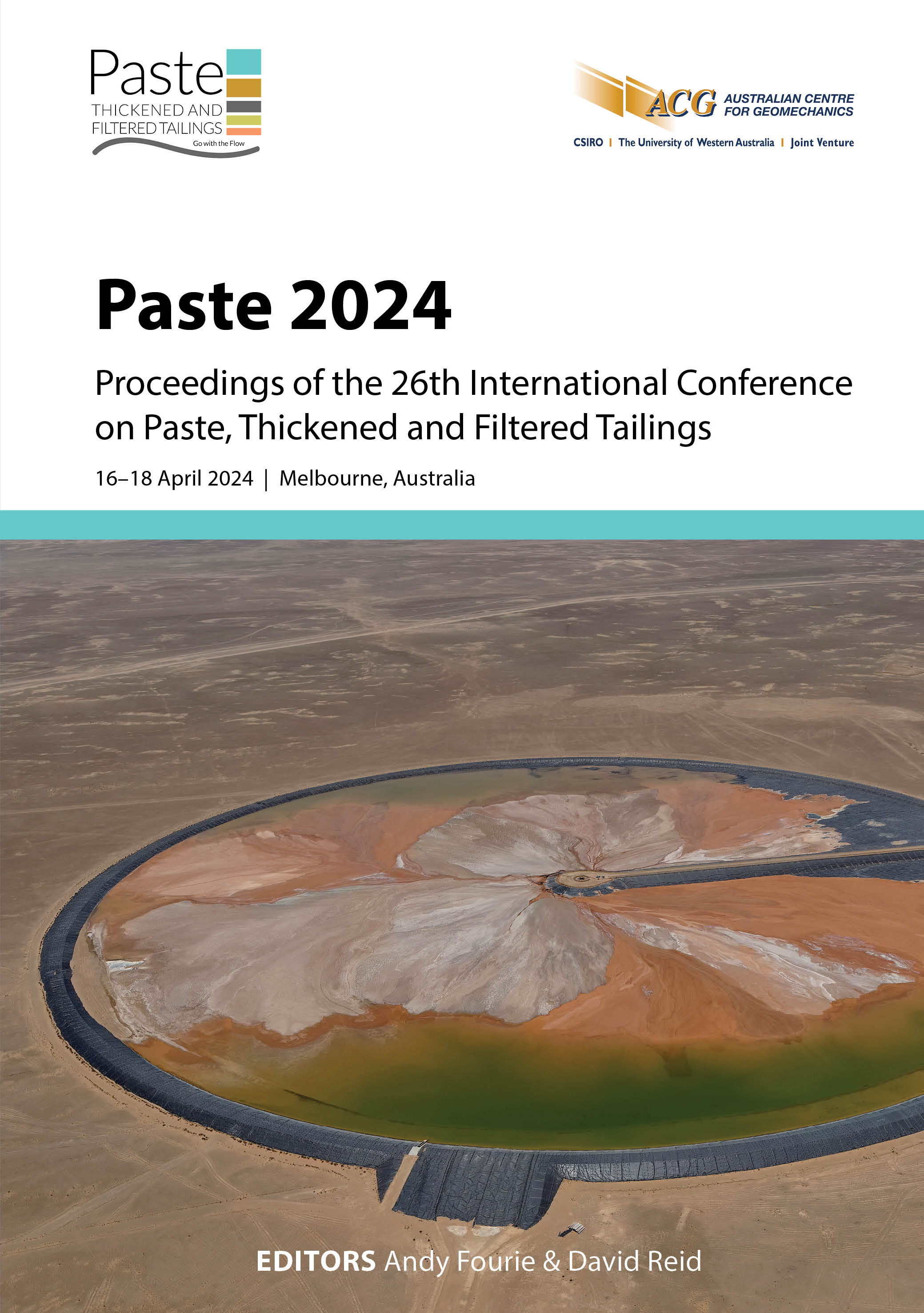Farmed tailings stacking

|
Authors: Li, H; Hinton, J; Navarro, J |
DOI https://doi.org/10.36487/ACG_repo/2455_15
Cite As:
Li, H, Hinton, J & Navarro, J 2024, 'Farmed tailings stacking', in AB Fourie & D Reid (eds), Paste 2024: Proceedings of the 26th International Conference on Paste, Thickened and Filtered Tailings, Australian Centre for Geomechanics, Perth, pp. 193-198, https://doi.org/10.36487/ACG_repo/2455_15
Abstract:
Recent catastrophic high-profile tailings dam failures such as Fundão and Brumadinho have regenerated interest in tailings dewatering and dry stacking as risks of catastrophic failures or runout associated with wet tailings disposal or conventional tailings storage facilities are dramatically reduced or totally eliminated. Dry stacking is normally achieved using filtered tailings which has low moisture content and cannot be pumped. Filtered tailings is generated by high-rate thickeners followed by filtration. An alternative method to filtered tailings is to dewater tailings and accelerate consolidation in situ through mud/tailings farming, especially in regions where evaporation rates are high and rainfall is relatively low. Mud farming is not a new technology and has been applied in the alumina industry for decades. It can be used to generate tailings with solids content as high as those that can be achieved by filtration and create structural zones for safe and stable tailings storage facilities. The method requires low capital and operational expenditure, substantially less than that required by the filtration process. This paper presents an alternative approach for dry stacking using farmed tailings. Key aspects for farmed tailings stacking, including water management, tailings farming, and disposal area/tailings cycle time are discussed. Water management is to ensure the decant pond in a tailings storage facility is minimised such that tailings in the structural zones can be farmed at all weather conditions. In order to achieve required tailings density and strength in the structural zones for safe and stable facilities, proper farming equipment, methodologies and assurance are needed and tailings cycle time between two consecutive tailings depositions should be adequate for tailings air drying and farming. In this stacking, dam safety relies on the farmed tailings in the structured zones and thus, only small bund walls are required for tailings containment and surface water management.
Keywords: mud farming, filtration, tailings stacking, tailings, water management
References:
Cooling, DJ 2007, ‘Improving the sustainability of residue management practices — Alcoa World Alumina Australia’, in R Jewell
& AB Fourie (eds), Paste 2007: Proceedings of the Tenth International Seminar on Paste and Thickened Tailings, Australian Centre for Geomechanics, Perth, pp. 3–16.
Haliburton, TA 1978, Guidelines for Dewatering/Densifying Confined Dredged Material, technical report DS-78-11, U.S. Army Engineer Waterways Experiment Station, Vicksburg.
Li, H & Richter, P 2010, ‘Case studies — integrated approach to design, construction and operations for tailings storage facilities’,
in R Jewell & AB Fourie (eds), Mine Waste 2010: Proceedings of the First International Seminar on the Reduction of Risk in the Management of Tailings and Mine Waste, Australian Centre for Geomechanics, Perth, pp. 35–47,
Li, H, Pedrosa, S & Canfell, A 2011, ‘Case study – bauxite residue management at Rio Alcan Gove, Northern Territory, Australia’,
in RJ Jewell & AB Fourie (eds), Paste 2011: Proceedings of the 14th International Seminar on Paste and Thickened Tailings, Australian Centre for Geomechanics, Perth, pp. 203–212.
McPhail, GI, DiDonna, P & Ugaz, R 2021, ‘Dam break analysis for BRDA 5 at Worsley Alumina Refinery’, in AB Fourie & D Reid (eds), Paste 2021: Proceedings of the 24th International Conference on Paste, Thickened and Filtered Tailings, Australian Centre for Geomechanics, Perth, pp. 177–200,
Munro, LD & Smirk, D 2012, ‘Optimising bauxite residue deliquoring and consolidation’, Proceedings of the 9th International Alumina Quality Workshop, pp. 269-275.
Willan, MB & Ghataora, GS 2015, ‘Management of bauxite residue in a temperate climate using mud‑farming techniques’, in R Jewell & AB Fourie (eds), Paste 2015: Proceedings of the 18th International Seminar on Paste and Thickened Tailings, Australian Centre for Geomechanics, Perth, pp. 209–222,
Woolston, JS & DiDonna, P 2020, A Case Study Comparison of Best Available Technology for the Stacking of Bauxite Residue: Accelerated Mechanical Consolidation (AMC) and Filtration & Stacking (F&S).
© Copyright 2026, Australian Centre for Geomechanics (ACG), The University of Western Australia. All rights reserved.
View copyright/legal information
Please direct any queries or error reports to repository-acg@uwa.edu.au
View copyright/legal information
Please direct any queries or error reports to repository-acg@uwa.edu.au
